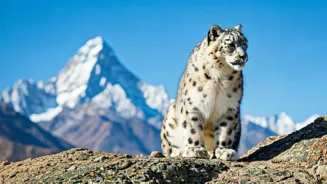The Snow Leopard
The elusive snow leopard (Panthera uncia) is a magnificent creature perfectly adapted to the harsh conditions of the high mountains. Sporting a thick coat
of fur, it's built to endure freezing temperatures. They are masters of camouflage, blending seamlessly with the rocky terrain and snowy landscapes. As apex predators, they play a vital role in maintaining the balance of the ecosystem. They primarily hunt animals like blue sheep and ibex, and their presence is a sign of a healthy environment. Spotting a snow leopard is a rare treat, offering a glimpse into the wild beauty of the Himalayas.
Himalayan Musk Deer
The Himalayan musk deer (Moschus leucogaster) is known for the unique musk it produces, a highly prized substance used in traditional medicine and perfumes. This small deer is easily identified by its small size, and the males have long, curved tusks instead of antlers. Their habitat is primarily in the alpine regions of the Himalayas, where they graze on grasses and herbs. Their existence is threatened by habitat loss and poaching due to their valuable musk. Conservation efforts are crucial to protect these remarkable creatures and their vital role in the mountain ecosystem.
The Himalayan Tahr
The Himalayan tahr (Hemitragus jemlahicus) is a large ungulate adapted to the rugged mountain terrain. Known for their thick, reddish-brown coat and curved horns, they are skilled climbers and navigators of steep slopes. They are often seen grazing on grassy slopes. They are a significant part of the Himalayan ecosystem, and their presence contributes to the region's biodiversity. These animals face threats like habitat destruction and hunting, so their protection is an important concern for conservationists and local communities.
The Red Panda
The Red Panda (Ailurus fulgens), with its reddish-brown fur and fluffy tail, is a charming mammal. Despite its name, it is not closely related to the giant panda. It is primarily a tree-dwelling animal, spending most of its time in the canopies of the forests, feeding on bamboo, fruits, and insects. Their survival is under threat due to deforestation and habitat loss. Various conservation programs are helping to protect their habitat and promote their safety in the Himalayas. The Red Panda's presence is a key sign of a healthy Himalayan environment.
Himalayan Brown Bear
The Himalayan brown bear (Ursus arctos isabellinus) is a large, powerful bear species found in the higher reaches of the Himalayas. Their fur color varies from reddish-brown to yellowish-brown, allowing them to blend in with their surroundings. As omnivores, they eat a wide variety of foods, including plants, fruits, insects, and occasionally, larger animals. Their role in the ecosystem involves seed dispersal and regulation of other animal populations. They are endangered due to habitat loss and conflicts with humans, making it essential to safeguard them.
Blue Sheep (Bharal)
The Blue Sheep, also called Bharal (Pseudois nayaur), is a fascinating animal that appears blue from a distance, because of their coat color. These sheep are perfectly suited to the harsh mountain environment, with their thick fur keeping them warm and their agility allowing them to navigate steep terrain with ease. They are an important food source for predators like snow leopards and play an essential role in the ecosystem. Conservation is required, given the threats they face. They depend on healthy grazing lands and face challenges from habitat destruction.
The Tibetan Wolf
The Tibetan Wolf (Canis lupus chanco), a subspecies of the gray wolf, is a top predator in the Himalayas. These wolves are a crucial part of the ecosystem, controlling the populations of various ungulates and other animals. Tibetan wolves have adapted to the harsh conditions with thick fur and strong builds. They play an essential role in the environment, keeping populations of other animals in check. Preserving their habitat is essential for their survival. Their presence indicates a functioning and complete ecosystem.
The Tibetan Antelope
The Tibetan Antelope, commonly known as Chiru (Pantholops hodgsonii), is a remarkable animal known for its fine wool called shahtoosh. The Chiru is perfectly adapted to high-altitude environments, with thick fur and efficient oxygen intake. They are often found grazing in the Tibetan Plateau. The trade of shahtoosh has severely threatened their existence, and conservation efforts are crucial to protect these unique creatures. Protection of their habitat will ensure the survival of this magnificent species.
Himalayan Monal
The Himalayan monal (Lophophorus impejanus) is a stunning bird with colorful plumage that inhabits the high-altitude forests of the Himalayas. The male monal is particularly striking, with iridescent feathers of green, blue, red, and copper, while the females have more subdued colors. They are ground-dwelling birds. They play an important role in seed dispersal and maintaining the health of forest ecosystems. Protecting their forest habitats will provide these beautiful birds a safe home for many generations to come.
Himalayan Black Bear
The Himalayan black bear (Ursus thibetanus) is a distinctive species with a V-shaped white or cream-colored marking on its chest. They have a thick coat and strong claws that help them climb trees and dig for food. They are omnivores, eating plants, fruits, insects, and occasionally small animals. They contribute to the health of the Himalayan forests by spreading seeds. They face dangers from habitat loss and human conflict, requiring ongoing protection. Preserving the habitat of the Himalayan black bear is key for its continued survival.

